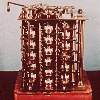Skip over navigation

Or search by topic
Number and algebra
Geometry and measure
Probability and statistics
Working mathematically
Advanced mathematics
For younger learners
Ishango Bone
Age 7 to 18
Challenge Level 





- Problem
- Getting Started
- Student Solutions
- Teachers' Resources
Why do this problem?
This short problem provides an interesting insight into the history of mathematics and into the nature of hypotheses: a hypothesis cannot be proved correct, merely reinforced or rejected on the acquisition of new information.Possible approach
Trying to spot number patterns is an easy activity, in this
problem we would like students to make clear hypotheses which are
consistent with the data. In some sense, any hypothesis which the
numbers do not contradict is equally valid, although some might
seem more reasonable than others.
Students could try to consider possible patterns in pairs and
then to share their ideas. As a class, can the group decide on the
best hypotheses? Encourage students to write down their hypotheses
clearly.
Key questions
What patterns do these numbers exhibit?
Can you write down a clear hypothesis stating the rules
underlying the structure of the numbers?
Discuss the question 'How would we be able to work out whose
hypothesis is correct?' (we can't!)
Possible extension
Interested students might like to follow the historical links. Alternatively, they might like to consider the creation of extreme, outlandish explanations for the numbers.Possible support
Provide calculators to allow students to test number rules.You may also like
Divided Differences
When in 1821 Charles Babbage invented the `Difference Engine' it was intended to take over the work of making mathematical tables by the techniques described in this article.

